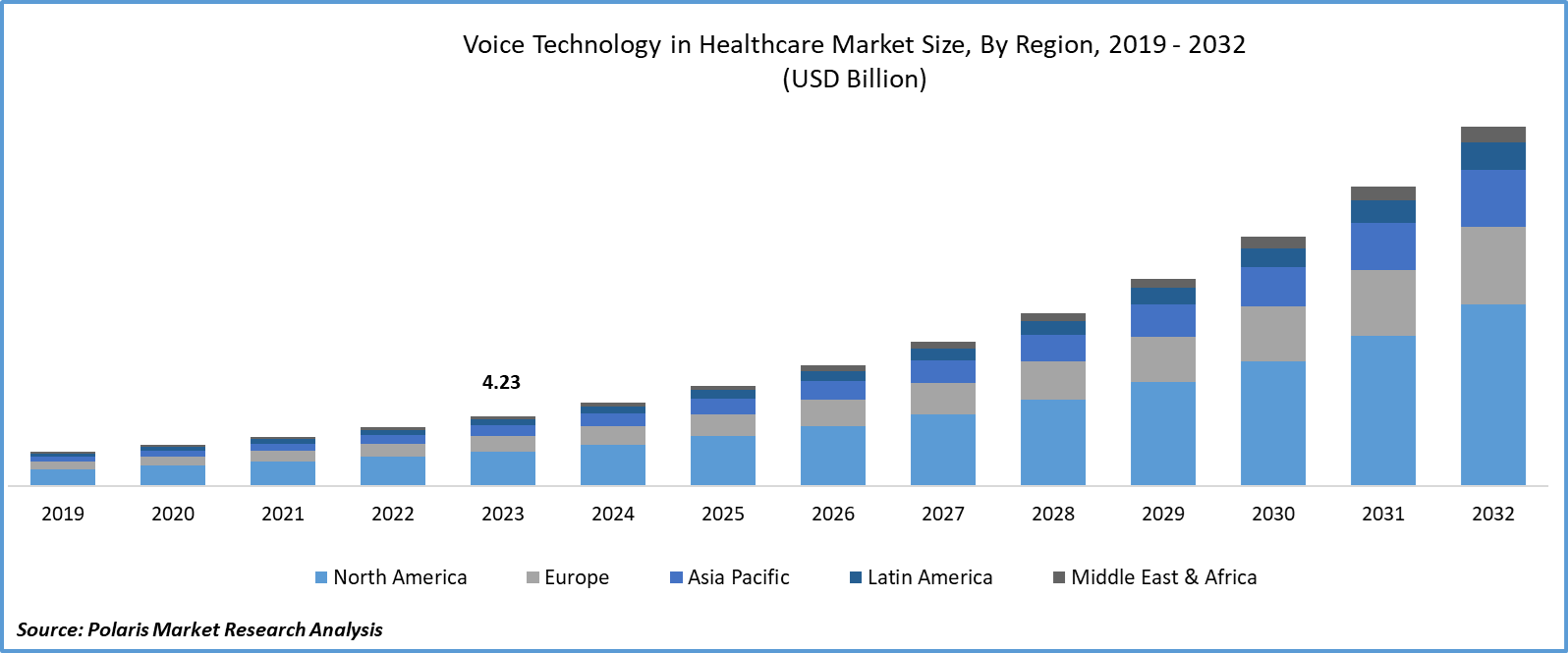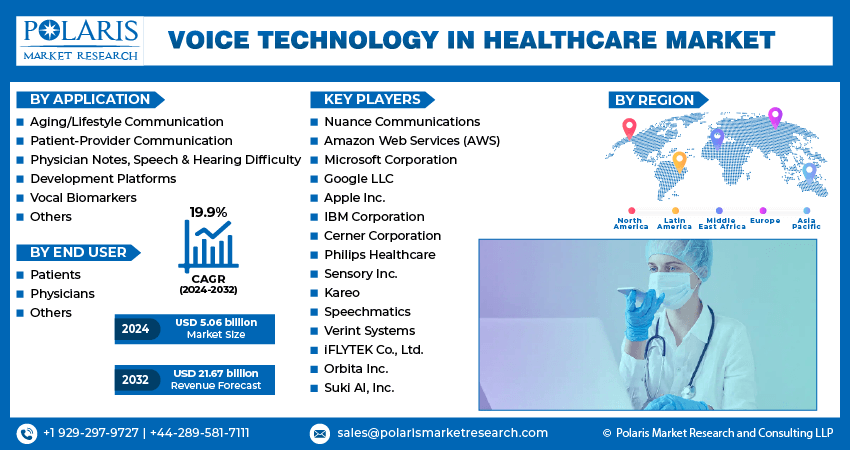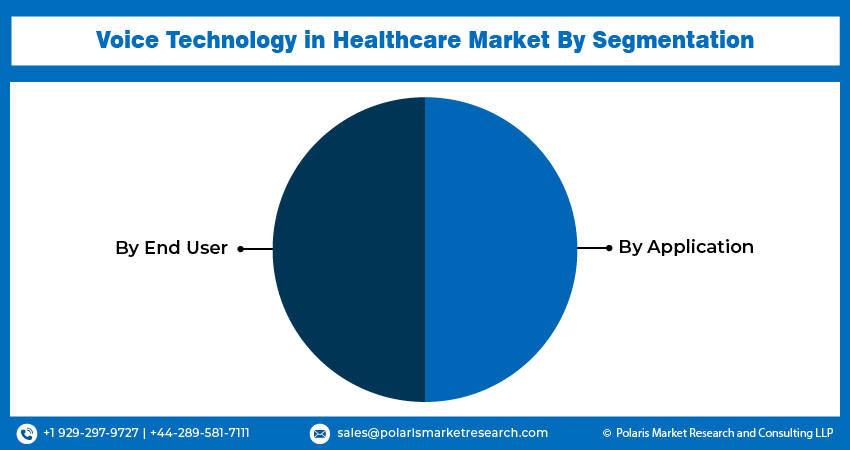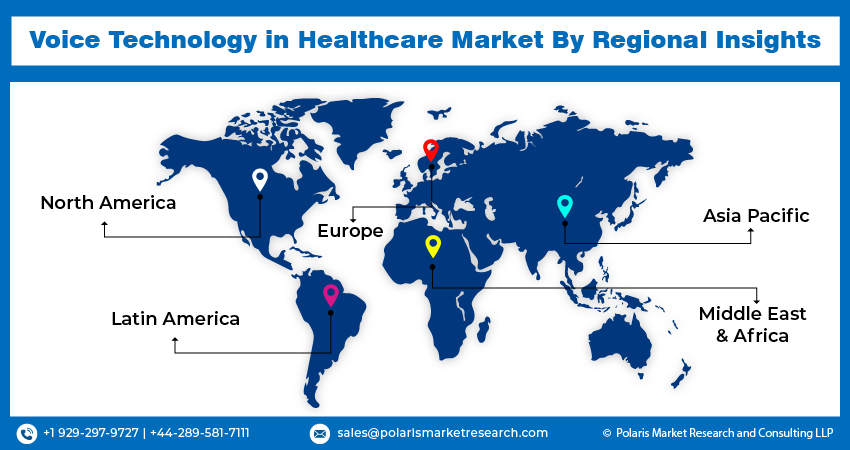
Voice Technology in Healthcare Market Size, Share, Trends, Industry Analysis Report
: By Applications, By End User (Patients, Physicians, and Others), and By Region (North America, Europe, Asia Pacific, Latin America, and Middle East & Africa) – Market Forecast, 2024 - 2032
- Published Date:Aug-2024
- Pages: 119
- Format: PDF
- Report ID: PM5033
- Base Year: 2023
- Historical Data: 2019-2022
Report Outlook
The global voice technology in healthcare market size was valued at USD 4.23 billion in 2023. The market is projected to grow from USD 5.06 billion in 2024 to USD 21.67 billion by 2032, exhibiting a CAGR of 19.9% during the forecast period. Voice technology in the healthcare market refers to the use of voice recognition and speech-to-text systems to enhance patient care, streamline administrative tasks, and support clinical documentation. It improves efficiency, accuracy, and accessibility in medical settings. The global voice technology in the healthcare market is witnessing rapid growth, driven by the increasing demand for hands-free healthcare solutions and the integration of artificial intelligence (AI) in medical diagnostics. The market’s additional key drivers include the need for improved patient engagement, enhanced clinical workflows, and the rising adoption of smart devices in healthcare settings. Moreover, voice technology is becoming a crucial component of contemporary healthcare innovation, driven by trends like the use of voice-activated virtual assistants for patient monitoring, voice recognition for managing electronic health records (EHRs), and voice-enabled AI for individualized patient care.

To Understand More About this Research:Request a Free Sample Report
Voice Technology in Healthcare Market Drivers and Trends
Integration with Electronic Health Records (EHR)
Healthcare professionals are increasingly using voice-activated systems to streamline the documentation process, reducing the time spent on data entry and improving the accuracy of patient records. This integration allows physicians to update patient information, retrieve data, and manage records hands-free, leading to more efficient clinical workflows and reducing administrative burdens. As voice recognition technology continues to evolve, its application in electronic health records (EHR) systems is expected to expand, providing healthcare providers with a more intuitive and efficient way to manage patient data. As a result, the voice technology in healthcare market is expanding.
Rise of Voice-Activated Virtual Assistants
The use of voice-activated virtual assistants in healthcare is on the rise, driven by the need for more personalized and accessible patient care. These assistants, powered by AI, are being deployed in various healthcare settings to assist with tasks such as appointment scheduling, medication reminders, and patient monitoring. Patients can interact with these virtual assistants through voice commands, making healthcare more accessible, especially for those with disabilities or chronic conditions. This trend is transforming patient engagement, enabling healthcare providers to offer more personalized care and improving overall patient satisfaction.
Adoption of Voice-Enabled AI for Diagnostics
Voice-enabled AI is increasingly being adopted in the healthcare sector for diagnostic purposes. Advanced algorithms can analyze voice patterns to detect early signs of diseases such as Parkinson's, Alzheimer's, and respiratory conditions. This non-invasive diagnostic tool is gaining traction as it offers a quick, cost-effective, and accurate method for early disease detection. The ability to diagnose conditions through voice analysis represents a significant shift in how healthcare providers approach diagnostics, potentially leading to earlier interventions and better patient outcomes. As AI technology continues to advance, the adoption of voice-enabled diagnostics is expected to grow, further solidifying its role in modern healthcare.

Voice Technology in Healthcare Market Segment Insights
Voice Technology in Healthcare Market Breakdown by Application Insights
The voice technology in healthcare market, based on application, is bifurcated into aging/lifestyle communication, patient-provider communication, physician notes, speech & hearing difficulty, development platforms, vocal biomarkers, others. In voice technology in healthcare market, patient-provider communication emerges as the dominating segment. This segment's dominance is driven by the increasing adoption of voice-activated systems that facilitate seamless communication between patients and healthcare providers, especially in clinical settings where efficiency and accuracy are paramount. Voice technology enhances the quality of care by enabling real-time interaction, improving the patient experience, and reducing the risk of errors in information exchange. The growing focus on telemedicine and remote consultations, especially post-pandemic, has further accelerated the adoption of voice technology in patient-provider communication, solidifying its leading position in the market.
Vocal biomarkers also represent the highest-growing segment within the market. This segment is experiencing rapid growth due to the innovative use of voice analysis to detect and monitor a range of health conditions, including neurological disorders, respiratory illnesses, and mental health issues. The ability of vocal biomarkers to provide early diagnosis and continuous monitoring of patients, often in a non-invasive manner, is driving interest from both healthcare providers and researchers. The rising investment in AI-driven diagnostic tools and the increasing demand for personalized healthcare solutions are further propelling the growth of this segment, making it a key area of focus for future developments in the market.
Voice Technology in Healthcare Market Breakdown by End User Insights:
The voice technology in healthcare market, based on end user, is bifurcated into patients, physicians, and others. In the voice technology in healthcare market, the physicians segment dominates the market, driven by the widespread adoption of voice-activated tools that enhance clinical efficiency. Physicians increasingly rely on voice technology for tasks such as dictating patient notes, accessing medical records, and communicating with other healthcare providers, all of which streamline their workflow and reduce administrative burdens. The integration of voice technology into EHR systems has further strengthened this segment, as it allows physicians to manage patient information more accurately and efficiently, leading to improved patient care and outcomes.
Another fastest-growing segment in the market is the patient’s segment, fueled by the rising use of voice-activated virtual assistants and AI-powered tools for personal health management. Patients are increasingly embracing voice technology for tasks such as scheduling appointments, receiving medication reminders, and accessing personalized health information. The convenience and accessibility offered by voice-enabled devices are particularly beneficial for elderly patients, those with disabilities, and individuals managing chronic conditions. As healthcare becomes more patient-centric and the demand for remote care solutions grows, the adoption of voice technology among patients is expected to continue its rapid expansion, making this segment a key area of growth in the market.
Global Voice Technology in Healthcare Market, Segmental Coverage, 2019 - 2032 (USD billion)

Source: Secondary Research, Primary Research, PMR Database, and Analyst Review
Voice Technology in Healthcare Market Breakdown by Regional Insights
By region, the study provides market insights into North America, Europe, Asia Pacific, Latin America, and the Middle East & Africa. North America dominates the voice technology in healthcare market due to its advanced healthcare infrastructure and the early adoption of innovative technologies. The presence of leading technology companies and substantial investment in healthcare IT have propelled the integration of voice technology in the region, particularly in the United States. North America's dominance is also supported by the high demand for digital health solutions, the widespread use of EHR, and the growing emphasis on telemedicine and patient-centered care.
In Europe, the voice technology in healthcare market is experiencing steady growth, driven by the region's focus on enhancing healthcare delivery through digital transformation. Countries such as Germany, the UK, and France are leading the adoption of voice technology, particularly in integrating voice-activated systems into hospital operations and patient care. The European healthcare sector's emphasis on improving patient engagement and reducing administrative workloads has encouraged the use of voice-enabled solutions. Additionally, the region's stringent data protection regulations, such as GDPR, have influenced the development of secure voice technology applications that prioritize patient privacy and data security.
Global Voice Technology in Healthcare Market, Regional Coverage, 2019 - 2032 (USD billion)

Source: Secondary Research, Primary Research, PMR Database, and Analyst Review
The Asia Pacific is also emerging as a significant player in the voice technology in healthcare market, with rapid growth driven by increasing healthcare investments and technological advancements. Countries including Japan, China, and India are at the forefront of adopting voice technology, particularly in the areas of patient-provider communication and telemedicine. The rising demand for healthcare services in these densely populated regions, coupled with the growing acceptance of digital health solutions, is propelling the adoption of voice technology. Moreover, government initiatives to modernize healthcare infrastructure and the increasing focus on personalized medicine are further boosting the market's growth in the Asia Pacific, making it one of the fastest-growing regions globally.
Voice Technology in Healthcare Market Key Market Players & Competitive Insights
Key players in voice technology in healthcare market include industry leaders and innovative startups that are driving the development and adoption of voice-enabled solutions. Major companies in this space include Nuance Communications, Amazon Web Services (AWS), Microsoft Corporation, Google LLC, Apple Inc., IBM Corporation, Cerner Corporation, Philips Healthcare, Sensory Inc., Kareo, Speechmatics, Verint Systems, iFLYTEK Co., Ltd., Orbita Inc., and Suki AI, Inc. These companies are at the forefront of integrating voice technology into various healthcare applications, ranging from patient communication to diagnostics and electronic health records management.
Amazon Web Services (AWS) and Microsoft Corporation are leveraging their cloud computing capabilities to provide scalable and secure voice technology solutions, positioning them as key competitors in the market. Google LLC and Apple Inc. are also strong contenders, with their AI-driven voice assistants increasingly being integrated into healthcare applications, particularly for patient engagement and monitoring. IBM Corporation continues to innovate in voice-enabled AI for diagnostics, while Cerner Corporation and Philips Healthcare focus on incorporating voice technology into their existing healthcare IT and medical device offerings.
The competitive landscape is characterized by rapid technological advancements, with companies continually enhancing their voice recognition capabilities, AI algorithms, and integration with healthcare systems. Startups like Suki AI, Inc. are making significant inroads with specialized voice solutions tailored to healthcare providers' needs, adding to the competitive pressure on established players. The market is also seeing increased collaboration and partnerships among these key players as they seek to expand their reach and enhance their product offerings. Overall, the competition in voice technology in healthcare market is intense, with companies vying to capture market share through innovation, strategic alliances, and a focus on improving healthcare outcomes through voice technology.
Nuance Communications is a major player in voice technology in healthcare market, particularly known for its Dragon Medical platform, which healthcare professionals widely used for voice-enabled clinical documentation. The company's expertise in AI-driven speech recognition has made it a preferred choice for integrating voice technology into EHR systems, enhancing efficiency and accuracy in healthcare settings.
Amazon Web Services (AWS) is another major player in the market, leveraging its robust cloud infrastructure to deliver scalable and secure voice technology solutions for healthcare. AWS's voice-enabled services, such as Amazon Lex and Amazon Transcribe Medical, are increasingly being used in telemedicine, patient monitoring, and EHR systems, providing healthcare providers with advanced tools for managing patient data and communication.
List of Key Companies in Voice Technology in Healthcare Market
- Nuance Communications
- Amazon Web Services (AWS)
- Microsoft Corporation
- Google LLC
- Apple Inc.
- IBM Corporation
- Cerner Corporation
- Philips Healthcare
- Sensory Inc.
- Kareo
- Speechmatics
- Verint Systems
- iFLYTEK Co., Ltd.
- Orbita Inc.
- Suki AI, Inc.
Voice Technology in Healthcare Industry Developments
- April 2023: AWS announced a partnership with the Mayo Clinic to develop new cloud-based AI and voice technology solutions aimed at improving patient care and operational efficiency, marking a significant milestone in their healthcare initiatives.
- March 2022: Microsoft acquired Nuance, which aims to accelerate the integration of AI and voice technology in healthcare through Microsoft's cloud services, further solidifying Nuance's market position.
Voice Technology in Healthcare Market Segmentation
Voice Technology in Healthcare - Application Outlook
- Aging/Lifestyle Communication
- Patient-Provider Communication
- Physician Notes, Speech & Hearing Difficulty
- Development Platforms
- Vocal Biomarkers
- Others
Voice Technology in Healthcare - End User Outlook
- Patients
- Physicians
- Others
Voice Technology in Healthcare - Regional Outlook
- North America
- US
- Canada
- Europe
- Germany
- France
- UK
- Italy
- Spain
- Netherlands
- Russia
- Rest of Europe
- Asia Pacific
- China
- Japan
- India
- Malaysia
- South Korea
- Indonesia
- Australia
- Vietnam
- Rest of Asia Pacific
- Middle East & Africa
- Saudi Arabia
- UAE
- Israel
- South Africa
- Rest of Middle East & Africa
- Latin America
- Mexico
- Brazil
- Argentina
- Rest of Latin America
Voice Technology in Healthcare Market Report Scope:
|
Report Attributes |
Details |
|
Market Size Value in 2023 |
USD 4.23 billion |
|
Market Size Value in 2024 |
USD 5.06 billion |
|
Revenue Forecast in 2032 |
USD 21.67 billion |
|
CAGR |
19.9% from 2024 to 2032 |
|
Base Year |
2023 |
|
Historical Data |
2019 – 2022 |
|
Forecast Period |
2024 – 2032 |
|
Quantitative Units |
Revenue in USD billion and CAGR from 2024 to 2032 |
|
Report Coverage |
Revenue Forecast, Market Competitive Landscape, Growth Factors, and Trends |
|
Segments Covered |
|
|
Regional Scope |
|
|
Competitive Landscape |
|
|
Report Format |
|
|
Customization |
Report customization as per your requirements with respect to countries, regions, and segmentation. |
How is the report valuable for an organization?
Workflow/Innovation Strategy: The voice technology in healthcare market has been segmented into detailed segments of applications, end users, and at both the global and regional levels segmentation.
Growth/Marketing Strategy: The growth and marketing strategy for the voice technology in healthcare market focuses on leveraging technological advancements and expanding application areas. Companies are investing in research and development to enhance voice recognition accuracy and integrate AI-driven features, aiming to offer more tailored and efficient solutions. Strategic partnerships and collaborations with healthcare providers are key to driving adoption, while targeted marketing campaigns emphasize the benefits of improved patient engagement and streamlined workflows. Additionally, expanding into emerging markets and addressing specific regional needs are vital for capturing a broader customer base and sustaining market growth.
FAQ's
The global voice technology in healthcare market size was valued at USD 4.23 billion in 2023 and is projected to grow to USD 21.67 billion by 2032.
The global market is projected to register a CAGR of 19.9% during the forecast period, 2023-2032.
North America had the largest share of the global market.
Key players in Voice Technology in Healthcare market include industry leaders and innovative startups that are driving the development and adoption of voice-enabled solutions. Major companies in this space include Nuance Communications, Amazon Web Services (AWS), Microsoft Corporation, Google LLC, Apple Inc., IBM Corporation, Cerner Corporation, Philips Healthcare, Sensory Inc., Kareo, Speechmatics, Verint Systems, iFLYTEK Co., Ltd., Orbita Inc., and Suki AI, Inc.
Patient-provider communication dominated the market in 2023.
The Physicians segment had the largest share of the global market.
Voice technology in healthcare refers to the use of voice recognition and processing systems to enhance various aspects of healthcare delivery and management. This technology enables voice-activated interactions and automated speech-to-text conversions, facilitating hands-free communication and documentation. Applications include dictating patient notes, managing electronic health records (EHR), enabling voice-activated virtual assistants for patient engagement, and utilizing voice-enabled AI for diagnostic purposes. By integrating voice technology, healthcare providers can improve efficiency, reduce administrative burdens, and enhance patient care through more streamlined and accessible communication.
Here are some key trends observed in voice technology in healthcare market: Integration with Electronic Health Records (EHR): Increasing use of voice technology to streamline documentation and manage patient records efficiently. Rise of Voice-Activated Virtual Assistants: Growing deployment of AI-powered voice assistants for tasks such as appointment scheduling, medication reminders, and patient monitoring. Adoption of Voice-Enabled AI for Diagnostics: Use of voice analysis to detect and monitor various health conditions, including neurological and respiratory disorders. Enhanced Patient Engagement: Voice technology facilitates better communication and engagement between patients and healthcare providers.
A new company entering the Voice Technology in Healthcare market could focus on areas such as developing advanced AI-driven voice recognition systems that offer high accuracy and contextual understanding. Emphasizing integration with Electronic Health Records (EHR) and creating solutions that enhance patient-provider communication and engagement would be crucial. Additionally, prioritizing data security and compliance with regulations like GDPR and HIPAA can differentiate the company from competitors. Exploring niche applications, such as voice-enabled diagnostics for specific health conditions, and offering tailored solutions for emerging markets could also provide a competitive edge.
Companies offering products, solutions, and services for voice technology in healthcare and other consulting firms.
